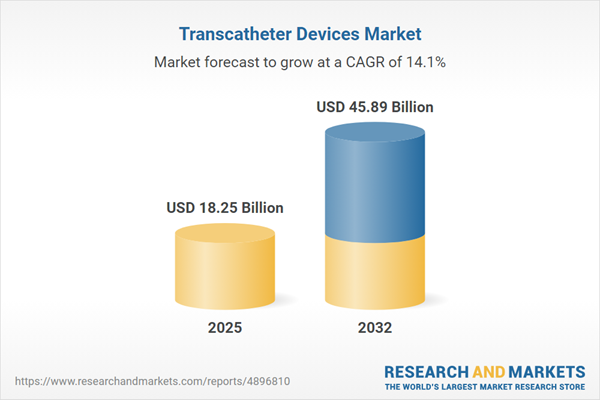Speak directly to the analyst to clarify any post sales queries you may have.
Senior decision-makers in healthcare require actionable intelligence to confidently navigate the evolving landscape of the transcatheter devices market. This report delivers practical insights into regional trends, care model innovation, and technology adoption, enabling clear prioritization and robust strategy planning.
Market Snapshot: Transcatheter Devices Market
The global transcatheter devices market is set for significant growth, driven by increasing clinical demand for minimally invasive cardiac treatments. The sector's value is anticipated to rise sharply, with a compound annual growth rate that outpaces many other medtech niches. Technological innovation and growing acceptance among clinicians are leading to wider adoption across key regions, with active participation from the Americas, Europe, Asia-Pacific, and the Middle East & Africa. Market expansion is further supported by the convergence of device engineering and clinical practice advances.
Scope & Segmentation
This report provides targeted segmentation and market scope, equipping healthcare leadership teams with focused analysis for investment and expansion decisions. Key categories reflect the intersection of innovation, commercialization strategy, and application in the transcatheter devices market:
- Product Types: Includes delivery systems, embolic protection devices, heart valves, occluders, and vascular closure devices, supporting a range of clinical requirements from access to post-surgical care.
- Delivery System Types: Both catheter-based and sheath-based solutions facilitate accurate device positioning and procedure flexibility in diverse clinical settings.
- Embolic Protection Devices: Encompass filter-based, occlusion balloon, and proximal protection options to lower procedural risk during interventions.
- Heart Valve Types: Offer treatments for aortic, mitral, pulmonary, and tricuspid valve conditions, expanding choices for cardiac specialists.
- Occluders: Address closure needs for atrial septal defects, left atrial appendage, and patent foramen ovale, relevant to both congenital and acquired heart conditions.
- Vascular Closure Devices: Feature extravascular clips, intravascular plugs, and suture-based systems, supporting hemostasis and patient recovery.
- Applications: Cover procedures such as aortic valve replacement, mitral valve repair, atrial septal defect closure, left atrial appendage occlusion, patent foramen ovale closure, pulmonary valve replacement, and tricuspid valve repair.
- Access Routes: Incorporate transaortic, transfemoral, transapical, transjugular, and transseptal pathways, ensuring procedural adaptability to varying patient profiles and facility capabilities.
- End Users: Address requirements and adoption patterns spanning hospitals, ambulatory surgical centers, and cardiac specialty clinics throughout care pathways.
- Distribution Channels: Focus on direct sales and distributor relationships as key enablers of market entry and commercial scale.
- Regions: Analyze trends, adoption rates, and regulatory environments in the Americas, Europe, Middle East & Africa, and Asia-Pacific, with each region showing unique market opportunities and challenges.
- Featured Companies: Assess the competitive landscape for Edwards Lifesciences, Medtronic, Abbott, Boston Scientific, W. L. Gore & Associates, Terumo, Cook Medical, MicroPort Scientific, Biotronik SE & Co. KG, and Merit Medical Systems, with emphasis on strategic positioning and R&D innovation.
Key Takeaways for Decision-Makers
- Engineering advancements and use of advanced materials, such as integration with medical imaging, are enhancing device safety and expanding clinical applicability for transcatheter solutions.
- Adoption of minimally invasive procedures supports faster patient recovery and encourages entry of new facilities into advanced cardiac intervention.
- Demographic changes and rising prevalence of cardiac valve disorders are prompting broader acceptance of advanced device platforms in both developed and emerging markets.
- Collaboration among device manufacturers, imaging technology companies, and academic research groups speeds product development and supports compliance with evolving regulations.
- Regional strategy agility—including local market partnerships and pricing alignment—remains crucial to overcoming unique operational and commercialization barriers.
- Market leadership increasingly relies on robust clinical evidence generation, real-world data collection, and readiness to adapt to changes in healthcare reimbursement models.
Tariff Impact on Supply Chain & Competitive Dynamics
With the introduction of new United States tariffs on critical medical-grade materials beginning in 2025, transcatheter device manufacturers face growing supply chain and cost pressures. To offset these challenges, the industry is diversifying its supplier base and scaling up regional manufacturing. Increased strategic partnerships, especially among specialized companies, are becoming central to maintaining R&D momentum and managing financial impact.
Methodology & Data Sources
This analysis uses a comprehensive, multi-source approach. Data is drawn from proprietary industry databases, peer-reviewed studies, regulatory literature, and direct engagement with stakeholders across clinical, procurement, and executive roles. All findings are carefully validated to ensure actionable value and accuracy for critical decision-making.
Why This Report Matters
- Enables executives to spot new business opportunities and evaluate strategic alliances, streamlining entry and growth plans by region.
- Offers actionable insights to support procurement, portfolio investment, and product development in response to changing regulations and competition.
- Strengthens supply chain risk management strategies, supporting business continuity amid tariff-driven and regional market shifts.
Conclusion
This report delivers succinct, high-impact analysis to support targeted investment and strategic resilience in the transcatheter devices sector. Use these insights to guide sustainable growth and sustained market leadership.
Additional Product Information:
- Purchase of this report includes 1 year online access with quarterly updates.
- This report can be updated on request. Please contact our Customer Experience team using the Ask a Question widget on our website.
Table of Contents
3. Executive Summary
4. Market Overview
7. Cumulative Impact of Artificial Intelligence 2025
List of Figures
Samples

LOADING...
Companies Mentioned
The key companies profiled in this Transcatheter Devices market report include:- Edwards Lifesciences Corporation
- Medtronic plc
- Abbott Laboratories
- Boston Scientific Corporation
- W. L. Gore & Associates, Inc.
- Terumo Corporation
- Cook Medical LLC
- MicroPort Scientific Corporation
- Biotronik SE & Co. KG
- Merit Medical Systems, Inc.
Table Information
| Report Attribute | Details |
|---|---|
| No. of Pages | 197 |
| Published | October 2025 |
| Forecast Period | 2025 - 2032 |
| Estimated Market Value ( USD | $ 18.25 Billion |
| Forecasted Market Value ( USD | $ 45.89 Billion |
| Compound Annual Growth Rate | 14.0% |
| Regions Covered | Global |
| No. of Companies Mentioned | 11 |









